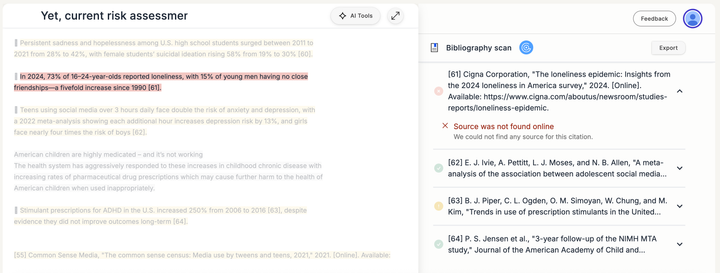From Catching to Coaching: How One Professor Added GPTZero to the Classroom
In most classrooms today, AI tools are kept behind the scenes. They’re used behind the scenes, often for lesson prep, grammar checks, or plagiarism detection. But Eddie del Val took a different approach: he brought AI right into the learning process.

In most classrooms today, AI tools are kept behind the scenes. They’re used behind the scenes, often for lesson prep, grammar checks, or plagiarism detection. But Eddie del Val, who teaches composition at Mt. Hood Community College in Oregon, took a different approach: he brought AI right into the learning process.
Eddie didn’t start that way. Like many educators, his first concern was upholding academic integrity. In an online environment, it was hard to tell whether students were submitting work that was truly their own, or something generated by AI. So he started using GPTZero.
“Even before generative AI became available to the public, I’ve always been vigilant about monitoring for appropriate and ethical use of sources and resources to inform, develop, and present thinking so as to guide students away from the more traditional forms of plagiarism,” Eddie explains. “Once generative AI came on the scene, I knew I was going to need help to more accurately discern human-generated text from AI text, especially in my online classes.”
He landed on GPTZero for its accuracy and useful results. “GPTZero helps me know if my students may be automating away the very important skills of revising and proofreading their own work instead of learning how to employ some of the more sophisticated and advanced grammatical structures used by AI.”
Initially, GPTZero acted as a signal, part of a holistic review to check for authenticity. Eddie’s aim wasn’t to “catch” students in a ‘gotcha’ moment; in fact, he was using it to coach them. It started as a way to understand student work more deeply, and ended up reshaping how he teaches writing altogether.

From Detection to Co-creation
About a year in, Eddie made a shift. He went from using GPTZero only behind the scenes to inviting students to use it themselves as part of the drafting process.
“Once I realized that generative AI was available to the public and wasn’t going anywhere except into more and more of what we all do both in our personal and working lives, I knew that I needed to create space for AI in my classroom and within the writing process,” he says.
GPTZero became part of the official course syllabus and resources, helping students check their own work before submission
“It’s not that I don’t want my students to use AI; I just want them to use it responsibly and ethically and in a way that will guide them to produce stronger, more organized thinking, so I encourage the use of AI as a thought partner while emphasizing that their writing must be stylistically and grammatically of their own making and must demonstrate a clear connection to their own original, unique thinking via the use of personal examples from their own lives.”
This became a foundational principle in Eddie’s pedagogy: AI wasn’t banned, it was bounded. Students could use it to brainstorm, revise, and explore ideas, but the voice, structure, and substance had to be theirs. GPTZero became a checkpoint in the process, and a way to reflect as opposed to simply detect.
“If I am encouraging students to use AI as a thought partner and as a tool to help them understand where their writing could use some further work, then my students also need tools to help them know if they have maintained enough of their own authenticity in the production of their work,” Eddie says.
“Since my students know exactly which AI detection software I am using (primarily GPTZero) they can use that same software and make sure that their final uploaded essay won’t be flagged for AI overdependence.”
In other words, students were responsible for holding themselves accountable and to fully own their writing process and work.
Helping Students 'Stay Behind the Wheel' of Their Writing
“GPTZero’s scans offer a level of granularity that not only helps me understand where students may be leaning on AI too heavily but also helps my students potentially see where they may have used AI too much for help with their word choice or sentence structures,” Eddie explains.
He walks students through how to interpret the highlights: “If you see a lot of yellow highlighting, especially the darker yellow highlighting, then consider what may be happening there. Did you rely on AI for too much assistance in that spot? If so, and you like the AI-suggested revisions to your writing, what did AI recommend compared to what you had previously?”
He continues: “Can you see in the AI-suggested revision anything that we may have covered and discussed in our class, such as the use of an adjective clause, noun phrase appositive, or verbal phrase? If so, rework that section of your writing so as to make it more your own by practicing with the sentence structures we have been learning about.”
This is the kind of metacognitive awareness Eddie wants students to build – taking the goal beyond simply turning in polished prose, but also including a deep understanding of how they got there.
Students are encouraged to use tools like ChatGPT and GPTZero, but reminded to stay in the driver’s seat when it comes to their own thinking and writing
“I would rather have them be responsible for this than be a writing instructor who steers student writers away from using AI and/or who keeps the AI detection software I use a secret so as to catch offending students.”
This commitment is built directly into his course materials. You can see below how Eddie’s syllabus outlines four steps for students unsure about their writing or AI usage, including consulting him, visiting the writing centre, using GPTZero to self-assess, and (most importantly) ensuring that their writing remains their own.
A More Nuanced Grading Process
Known in his department as a tough grader, Eddie didn’t see AI as a shortcut. Instead, he saw it as a tool to help students better understand what he was already asking of them.
“It’s not like I just have to wholeheartedly accept what the AI is spinning my way,” he said. “But it's this hybridization to the grading process. It provides this nice structure for me, a structure that I originally am giving it. And it is then using that structure as it evaluates the student writing.”
Eddie began uploading his own grading rubrics and criteria into GPTZero, experimenting with custom scoring scales and feedback. He saw the potential to streamline grading as well as to improve it.
“I’m deeply interested in exploring how GPTZero might be able to enhance my approach to grading based on what I’ve seen it do so far. I’m an instructor who tends to provide lots of feedback on student writing, not just cursory marks, which is critical for a student’s success in a writing class. GPTZero’s grading abilities may provide much more robust comments than what some composition instructors are able to provide, largely due to time constraints.”
In those cases, Eddie initiates a conversation. “I begin a dialogue over email with the student where I ask them to share their approach to their work while I simultaneously capture more writing from them that I can analyze further… I will gently remind them to use both AI detection tools in the future and to remain mindful about how much they lean on AI for assistance. That usually does the trick.”
“Just as we work to engage our students in what are appropriate uses of AI in the context of our classes, I think it's critically important that composition instructors and their departments have robust conversations around the appropriate use of AI in the grading process. Ultimately, teaching and learning effectiveness should remain at the center of these conversations.”
Seeing AI As a Thought Partner
Eddie’s approach is grounded in transparency. “I’m definitely an instructor who’s open to students using AI tools as long as they’re using them responsibly and ethically,” he says. “So I’d be transparent with them. I’d tell them I’m using it in a hybridized way, and I’d be curious to get their feedback too.”
He quotes Wharton professor Ethan Mollick to students: “The best way to understand AI is to bring it into everything you do and learn from the experience.” That curiosity and openness define Eddie’s teaching model.
“With any tool, I'm interested in ones that are going to help me be a better teacher and help me provide more value for my students in terms of what they receive from me. And I like that this tool forces me or prompts me or gives me opportunities to clarify my individual score way more than I currently do, all while hopefully making the grading process, which for so many teachers is so laborious, hopefully a lot easier.”
What we love about Eddie’s story is that he put GPTZero’s AI reviewer right into the course structure and asked students to engage with its feedback as part of their learning. By bringing AI into his syllabus, Eddie helped students build agency and responsibility. In doing so, he reframed AI as a coach, instead of demonizing it as a threat or a crutch. His view was that AI wasn’t only for detecting problems at the end: ideally, it was there to support stronger writing from the start.


